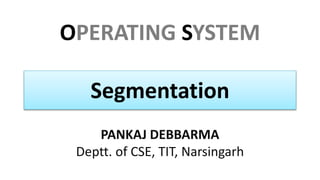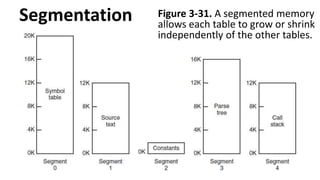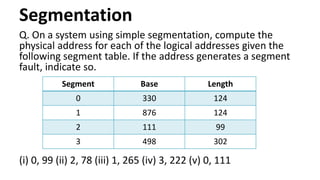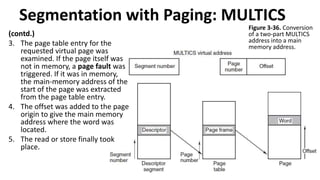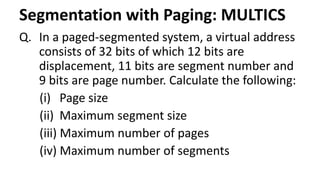OS-02 Segmentation.pptx
- 1. OPERATING SYSTEM PANKAJ DEBBARMA Deptt. of CSE, TIT, Narsingarh Segmentation
- 2. CONTENTS Segmentation âĒ Segmentation âĒ Segmentation with paging
- 3. Figure 3-30. In a one- dimensional address space with growing tables, one table may bump into another.
- 4. Segmentation Figure 3-31. A segmented memory allows each table to grow or shrink independently of the other tables.
- 5. Segmentation
- 6. CONSIDERATION PAG. SEG. Need the programmer be aware that this technique is being used? No Yes How many linear address spaces are there? 1 Many Can the total address space exceed the size of physical memory? Yes Yes Can procedures and data be distinguished and separately protected? No Yes Can tables whose size fluctuates be accommodated easily? No Yes Is sharing of procedures between users facilitated? No Yes
- 7. Segmentation Why was paging invented? âĒ To get a large linear address space without having to buy more physical memory. Why was segmentation invented? âĒ To allow programs and data to be broken up into logically independent address spaces and to aid sharing and protection.
- 8. Segmentation Q. Consider the following segment table: What are the physical addresses for the following logical addresses ? (i) 0430 (ii) 110 (iii) 2500 (iv) 3400 (v) 4112 Segment Base Length 0 219 600 1 2300 14 2 90 100 3 1327 580 4 1952 96
- 9. Segmentation Q. On a system using simple segmentation, compute the physical address for each of the logical addresses given the following segment table. If the address generates a segment fault, indicate so. (i) 0, 99 (ii) 2, 78 (iii) 1, 265 (iv) 3, 222 (v) 0, 111 Segment Base Length 0 330 124 1 876 124 2 111 99 3 498 302
- 10. Figure 3-33. (a)-(d) Development of checkerboarding. (e) Removal of the checkerboarding by compaction.
- 11. Figure 3-34. The MULTICS virtual memory. (a) The descriptor segment pointed to the page tables. Segmentation with Paging: MULTICS âĒ 218 segments (262144) âĒ 1 segment = 65,536 (36- bit) words long âĒ Each segment treated as a virtual memory
- 12. Figure 3-34. The MULTICS virtual memory. (b) A segment descriptor. The numbers are the field lengths. Segmentation with Paging: MULTICS
- 13. Figure 3-35. A 34-bit MULTICS virtual address. Segmentation with Paging: MULTICS When memory reference occurs, following algorithm is carried out (Figure 3-36). 1. The segment number was used to find the segment descriptor. 2. A check was made to see if the segmentâs page table was in memory. If it was, it was located. If it was not, a segment fault occurred. If there was a protection violation, a fault (trap) occurred.
- 14. Segmentation with Paging: MULTICS (contd.) 3. The page table entry for the requested virtual page was examined. If the page itself was not in memory, a page fault was triggered. If it was in memory, the main-memory address of the start of the page was extracted from the page table entry. 4. The offset was added to the page origin to give the main memory address where the word was located. 5. The read or store finally took place. Figure 3-36. Conversion of a two-part MULTICS address into a main memory address.
- 15. Figure 3-37. A simplified version of the MULTICS TLB (16-word high speed). The existence of two page sizes made the actual TLB more complicated. Segmentation with Paging: MULTICS
- 16. Segmentation with Paging: MULTICS Q. In a paged-segmented system, a virtual address consists of 32 bits of which 12 bits are displacement, 11 bits are segment number and 9 bits are page number. Calculate the following: (i) Page size (ii) Maximum segment size (iii) Maximum number of pages (iv) Maximum number of segments

